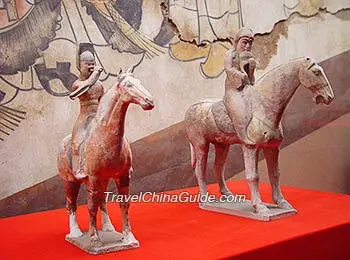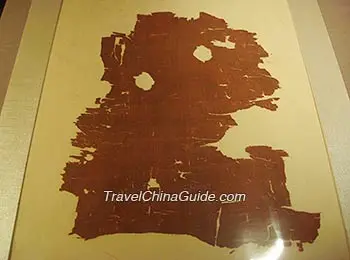Memorabilia along the Silk Road
Western Han Dynasty
| In 141 BC | Han Wudi succeeded to the throne. |
| In 139 BC | Zhang Qian was dispatched by Wudi to the Western Regions in order to make a military alliance with Da Yuezhi against the Huns. |
| In 126 BC | Zhang Qian returned to Chang'an (now Xi'an). |
| In 119 BC | Zhang Qian set out on his second journey to the Western Regions to unite Wusun against the Hun. The Silk Road originated at this time. |
| 129 BC-119 BC | Generals Wei Qing and Huo Qubing defeated the Huns; the Hexi Corridor was brought under the Han Dynasty's control. |
| In 77 BC | Fu Jiezi worked out a clever way to kill the king of Loulan, which overawed other states in the Western Regions and ensured peace on the road. |
| During the reign of the Han Xuandi (74 BC-49 BC) | Feng Liao, a great women diplomat, actively mediated the disputes of Wusun and other states in the Western Regions, which made the road flow freely. |
| In 60 BC | Han Dynasty established the Protectorate of Western Regions with its administration centre in Wulei (near now Luntai), overseeing the 36 states in this vast northwest area. |
Eastern Han Dynasty
| 73-94 | Ban Chao suppressed rebellions of some states in the Western Regions, which consolidated the dominion of the Han Dynasty and protected the Silk Road. |
| In 97 | In order to establish trade with Rome directly, Gan Ying was sent by Ban Chao to Daqin (now Rome); however, he only reached the Persian Gulf. |
| 123-126 | Using clever diplomacy and military talent, Ban Yong stabilized the Western Regions and reopened the Silk Road in this remote area. |
Tang Dynasty
| In 618 | The Tang Dynasty was established with its capital at Chang'an (now Xi'an) |
| In 629 | The great monk, Xuanzang departed from Chang'an to India along the Silk Road to study Indian sutras. |
| In 630 | The Tang Dynasty conquered the Eastern Turks. |
| In 640 | To strengthen its military management and to protect the Silk Road, the Protectorate General to Pacify the West was installed with four garrisons: Qiuci (Kuqa), Yanqi (Qarashar), Yutian (Hetian or Khotan) and Shule (Kashgar) |
| In 645 | Xuanzang returned to Chang'an with many Indian sutras. |
| In 658 | The Western Turks was completely subdued by the Tang Dynasty. |
| In 702 | Tang Dynasty set up the Protectorate General of Beiting with the military center in Tingzhou (now Jimsar) in order to manage the Northern Route of the Silk Road. |
| In 751 | The method for making paper was transmitted to the West. |
| In 755 | Anshi Rebellion broke out and lasted for seven years. After the rebellion, the Silk Road began to decline. |
Yuan Dynasty
| In 1206 | Genghis Khan built the Mongol Empire. |
| 1206-1227 | Genghis Khan successively subdued Liao (Qidan), Jin and Xixia and other states in the Western Regions and West Asia. The Silk Road became prosperous again. |
| In 1271 | The Mongolian ruler Kublai Khan established a Chinese dynasty at Dadu (the present Beijing) with the largest territory in Chinese history including the Central Asia and Russia. As a result, the road reinstated its vigor and became busy again. |
| 1271-1275 | Marco Polo traveled along the ancient Silk Road to China with his father and uncle. |
| 1275-1292 | Marco Polo stayed in the court of Kublai Khan for 17 years; he became well acquainted with information about China, Central Asia, West Asia and Southeast Asia. |
| In 1298 | The Travels of Marco Polo came out, which became the most influential travelogue and paved the way for the arrivals of many Westerners. |
Tiemuer Empire
| 1368-1404 | Tiemuer, a descendant of Genghis Khan, established a powerful empire in Samarkand with the vast territory from New Delhi in the south to Damascus in the north, from the Aral Sea to the Persian Gulf. Samarkand became an important international trade centre of the Silk Road. As the Tiemuer Empire collapsed, the road gradually fell into disuse. |
|
|
- Last updated on Aug. 07, 2025 by Gabby Li -

